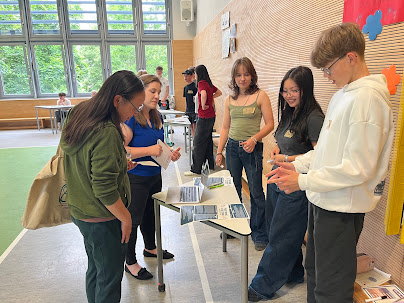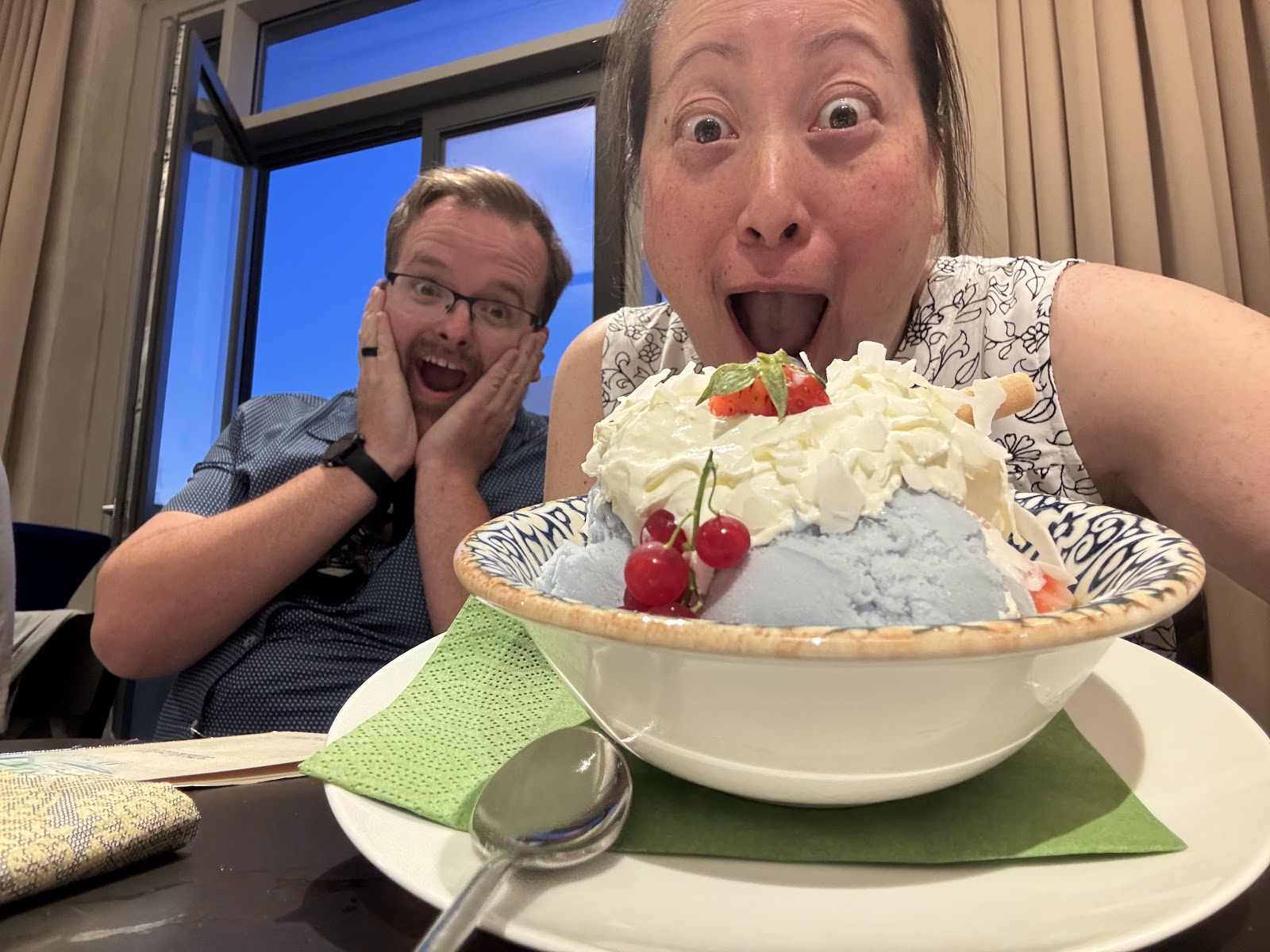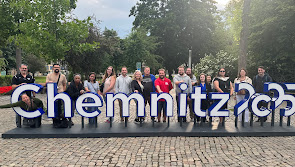TUESDAY, June 10 – Chemnitz
An early morning departure brought us to Chemnitz, an industrial city in the state of Saxony that was heavily bombed during WWII. Although the US Army was the first to arrive in 1945 to free Chemnitz, it became part of Soviet-controlled East Germany in accordance with the Yalta Conference. As part of the GDR, it was renamed Karl-Marx-Stadt from 1953 until the reunification of Germany in 1990, and Soviet influence can be seen throughout the city.
The second school was Chemnitzer Schulmodell, an alternative school for 1st – 10th graders. We were greeted with cakes and coffee, and tables highlighting student projects. The school had many student-led activities, projects, and electives – including a pizza oven, graffiti class, and woodworking. It is a highly desired school that uses a lottery system for admission, and it was easy to see why. Many of us teachers wanted to either work there… or attend!
Our host Franka grew up in East Germany and described what it was like living behind the Iron Curtain. She always had enough to eat, but there wasn’t a lot of choice in the things that they had. She explained that she never felt “want” since she didn’t know any different. It was much more difficult for her parents, who rebelled in small ways - for example, her father had long hair and wore blue jeans (gasp!). He had wanted to escape to the West, but her mother thought it was too dangerous since they had two small children.
One of the main reasons for our visit to Germany was to learn about their education system. We could interact with German teachers, and were lucky enough to visit several different schools during our time in the country.
* * * * * * * * * * * * * * * * * * * * * * * * * * * *
A Quick and Dirty Intro to the German Education System
Unlike the United States’s one-size-fits-all school system, there are many different types of secondary schools in Germany. Because educational policies are dictated by each of Germany’s 16 federal states, there can be significant regional differences. Typically, all children attend Grundschule (elementary school) from ages 6 to 10 (or 12, depending on the state). Afterward, students are placed into different secondary schools based on academic performance and teacher recommendations. The main types include Hauptschule, Realschule, and Gymnasium, each offering different academic and vocational emphases. Gymnasium prepares students for university, while the other tracks lead to vocational training or intermediate qualifications. Germany also has a well-developed dual education system, combining apprenticeships with classroom instruction, which supports a strong pathway into skilled trades and professions.
* * * * * * * * * * * * * * * * * * * * * * * * * * * *
Our first school visit was to the Johannes-Kepler Gymnasium, a 5th – 12th grade school with around 600 students. We began with a potato soup lunch in the students’ cafeteria, followed by a tour of the facilities led by the 9th grade students. It was interesting to note that both teachers and students go around to different classrooms, so teachers don’t have one room to call their own. Because of this, the inside of the classrooms seemed fairly generic and unadorned - but otherwise, it was similar to an American city school: everything was contained in one large building. After our school tour we gathered together for a question-and-answer session with the students – a common question they had was how often we experienced school shootings :(
 |
| Chatting with the Chemnitzer students |
(Side note: I don't have any photos from our school visits because Germany has very strict rules about photography - especially taking pictures of minors. Instead, I just enjoyed focusing on chatting with the students. Thanks for the photo, Philipp!)
Teacher Florian met us at our hotel to walk us to dinner. Did you know? Chemnitz was renamed Karl-Marx-Stadt from 1953 until reunification in 1990, when 76% of the people voted to change back to "Chemnitz." Along our walk, we stopped at the famous Karl Marx bust. This giant, 7 meter tall head was created in 1971 because, as the sculptor explained, “Karl Marx doesn’t need legs or hands; his head says it all.” This plaza was the site of many parades and state celebrations, and even today is a site for political demonstrations. It’s an example of Socialist Realist art, and it symbolizes GDR ideology and the city’s layered history.
In January, Chemnitz became the European Capital of Culture and began a year-long push to highlight, celebrate, and build up its arts and culture scene. All throughout the region (not just Chemnitz, but the 50-mile radius around the city – including parts of Austria and Poland), several initiatives bring dance, concerts, film, art, and other cultural activities to the people.
We learned about several of these projects, including a multigenerational dance project, the "Purple Path" (a series of sculpture instillations throughout the region), and “3000 Garages,” which bring neighborhood popup gatherings like readings and concerts to area garages. The garages emerged as somewhere for people to have storage as well as a place for gathering and hang-outs. These DIY structures are remnants of the Cold War era, since the apartments of the giant Soviet-style concrete block buildings were small and cramped.
 |
| October 9, 1971. Photo: Stadtarchiv Chemnitz |
 |
| Posing with Karl |
At dinner, we had a discussion on Germany’s political system. As a federal parliamentary republic, Germany has a parliament divided into two parts - the Bundestag, where members voted in, and the Bundesrag, whose members are sent by each of the 16 states. Unlike the US, Germany has several political parties so to get a majority vote, they must form coalitions. Because of this, there is more negotiating and compromise.
Currently, Germany faces many of the same issues that we do in the US - the Ukraine war is right in their backyard (only Poland separates Germany from Ukraine and before the war more than half their natural gas came from Russia). They face economic immigration challenges, and a far-right party similar to MAGA called Alternative for Germany (the AfD) is gaining a lot of support. So it's not just us!
 |
| With Lane and Kyle in the Theaterplatz |
WEDNESDAY, June 11 - Annaberg-Buchholz, Seiffen, & Dresden
We left Chemnitz and headed into the Ore Mountains, near the Czechia border. Our first stop was Evangelische Schulgemeinschaft Erzgebirge, a private Christian high school in Annaberg-Buchholz. It is located in a beautiful 125+ year-old former hospital built in the Neo-Renaissance style that was typical of state buildings in the German Empire. We toured the campus, which was beautiful, but much like the other German schools where both students and teachers change from room to room, each classroom had little personality. Communal work and study spaces are common, even for the teachers (who have a giant shared teacher work space on the top floor of the building).
 |
| The gorgeous main building of the Evangelische Schulgemeinschaft Erzgebirge |
We left Chemnitz and headed into the Ore Mountains, near the Czechia border. Our first stop was Evangelische Schulgemeinschaft Erzgebirge, a private Christian high school in Annaberg-Buchholz. It is located in a beautiful 125+ year-old former hospital built in the Neo-Renaissance style that was typical of state buildings in the German Empire. We toured the campus, which was beautiful, but much like the other German schools where both students and teachers change from room to room, each classroom had little personality. Communal work and study spaces are common, even for the teachers (who have a giant shared teacher work space on the top floor of the building).
Our next stop was to Seiffen, a former tin and silver mining village dating back to 1324. When mining slowed down, they turned to woodcraft and the area eventually became famous for making toys.
Today, Seiffen is more known for Christmas crafts – nutcrackers, candle pyramids, and ornaments. Seiffen artisans are particularly known for the technique Reifendrehen, where wooden rings are carved into softened wood so that slices of the ring can be chipped off to become animal figurines. There is no mold or guide for the rings; the artisan just knows where he has to cut, even though he can't see the cross section of the ring! Today, only 6 people are left in the world who know this carving technique – and they say no young people are interested in learning the craft, and so it is a dying art.
 |
| Artwork from the Purple Path in the Seiffen outdoor museum |
There is a lovely outdoor museum with both original and reconstructed buildings showing the life and culture of the Ore Mountain region from the mid-19th to early 20th century. We wandered around, seeing the homes built into the side of the hill (which made it easier to bring things upstairs) as well as the water wheel that provided the electricity needed to turn the lathes used for woodcarving.
After lunch, we continued north to the Saxony capital city, Dresden.
Dresden has a complex history, but I understand why our guides – teachers Uwe and Steffi – think of it as the most beautiful city on earth. The city flourished under Augustus the Strong (1694-1733), the Elector of Saxony, and was beautifully reconstructed after WWII. Looking at the city now it is easy to picture Dresden in its heyday.
* * * * * * * * * * * * * * * * * * * * * * * * * * * *
A Brief History Break: Augustus the Strong
Augustus II was nicknamed “The Strong” because of his great physical strength – he could break horseshoes with his bare hands! He also supposedly fathered 365 children, one for every day of the week, and he built a cathedral and converted to Catholicism just so that he could become King of Poland (since he really wanted to be King, but Saxony didn’t have kings at that time). At the time, there were no Catholics in Dresden, so he just put up a wall so nobody could see what was going on, and he brought Italian workers to come in and do the construction work. His body is buried in Krakow, but they removed his heart and brought it to Dresden Cathedral.). During his reign, many landmarks were built including palaces, churches, and the opera house.
* * * * * * * * * * * * * * * * * * * * * * * * * * * *
 |
| Outer wall of the Dresden Zwinger |
Then came WWII and the bombing of Dresden. In February 13-15, 1945, the Allies dropped over 3,900 tons of explosives in multiple waves, destroying a large portion of the city and killing tens of thousands of people – including refugees who came to the city thinking they would be safe. The bombing was highly controversial – Dresden wasn’t a major military or industrial hub, and Germany was already losing the war. Whether Allies did it to instill terror or to disrupt transportation routes, the result was complete devastation.
We then saw the Semperoper (opera house), then looked across the street at Dresden Castle. It is connected by a small bridge to the Dresden Cathedral (the one built by Augustus the Strong to show his Catholicism) as a way for them to never have to go outside (because... what if it’s raining??).
 |
| Dresden from the Rathaus (city hall), 1945. Photo: Deutsche Fotothek |
After German reunification much of Dresden was rebuilt as a symbol of reconciliation and peace, and the Innere Altstadt (old town) is beautiful and easily walkable. We started at the Zwinger Palace, a glorious baroque building built by Augustus the Strong in the early 1700s. The courtyard and gardens were created for the marriage of his son Fredrick Augustus to the daughter of the Habsburg emperor. It was one of the buildings destroyed during the bombing of Dresden, but has been rebuilt since the 1940s – when we visited, the inner courtyard was closed for construction. We looked across at the Crown Gate, honoring Augustus the Strong as King of Poland (since he wasn’t King of Saxony since they didn’t have a king).
 |
| Semperoper |
Between the old courthouse and the palace stables is a giant porcelain mosaic mural of all the Saxon rulers, first created in sgraffito (scratched plaster) in the 1870s and turned into porcelain in 1907 – the largest porcelain mural in the world (and it survived WWII!). Impressive!
We continued through to the Neumarkt Square in front of Frauenkirche, the Church of Our Lady. The original baroque building, built in the first part of the 18th century, was topped by the world’s largest sandstone dome. But after burning all night during the bombing of Dresden during WWII, the dome collapsed and the ruins of the church was subsequently left untouched for over 50 years as a war memorial and a symbol of loss. After reunification, it was completely reconstructed using funds from donations, including from the UK and US, and is now a symbol of reconciliation and peace.
After our tour, we walked along the terrace of the Elbe River and across the Augustebruke bridge to the new town. A huge golden statue of Augustus the Strong on a horse sits at the end of the bridge, ready to ride into Poland (where he was King). We walked along a tree-lined pedestrian walkway to dinner, where we had a lovely happy hour and dinner with German alumni from past Atlantik-Brücke trips. It was a lovely night and fun to see pictures of their experience visiting the US.
 |
| The mural of the Saxon kings |
 |
| Frauenkirche, before and after restoration |
 |
| King Augustus |
 |
| Evening along the banks of the Elbe |
THURSDAY, June 12 – Dresden
Today was filled with meetings, meetings, meetings! We started at the Ministry of Culture and Education for a discussion on Saxony’s education system. We met with Werner Glowka, the Department Head of General/Vocational Schools who gave us a briefing of their school system – at around 10-years old, children choose a ‘track’ and are educated based on whether they intend to get vocational training or attend university. It was interesting to hear about a completely different system of education, and yet many of the problems – with teacher training, student accountability, and limited resources - are the same.
 |
| In the metalworking lab |
 |
| Students are taught specialized skills such as welding |
We viewed the introductory metalworking lab, then moved up to the more specialized room where older students were learning soldering and welding; then to the most specialized lab where students could specialize on the specific equipment from a company. It was interesting to learn that they use VR to practice before actually using and ‘wasting’ metal.
Atlantik-Brücke member Karsten Uhlmann invited the group to tour his brewery, Feldschlößchen Brauerei. We took the brewery tour to see how beer is made – 2 weeks plus a day from start to finish. We got to taste his beer – and I tried both their Radler and the nonalcoholic Radler, a mixture of beer and lemonade, which was actually pretty good!
 |
| Brewmeister wanna-bes |
We had an hour of free time before dinner so Kyle and I did a bit of wandering and found a bookstore where I was able to get my German copy of The Little Prince – hooray!
 |
| The fascinating Socialist architecture and decor of downtown Dresden |
Then we took the tram across town to the Blaues Wonder Bridge and had dinner at the ElbeGarten Biergarten where we met up with City Councilwoman and SPD member Julia Hartl. She is passionate about social issues and helping her constituency, and it was interesting to hear her take on modern German politics and her frustrations and hopes.
 |
| It was the biggest bowl of ice cream I've ever seen....! |










No comments:
Post a Comment